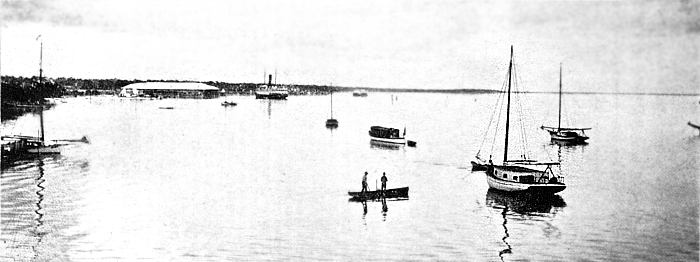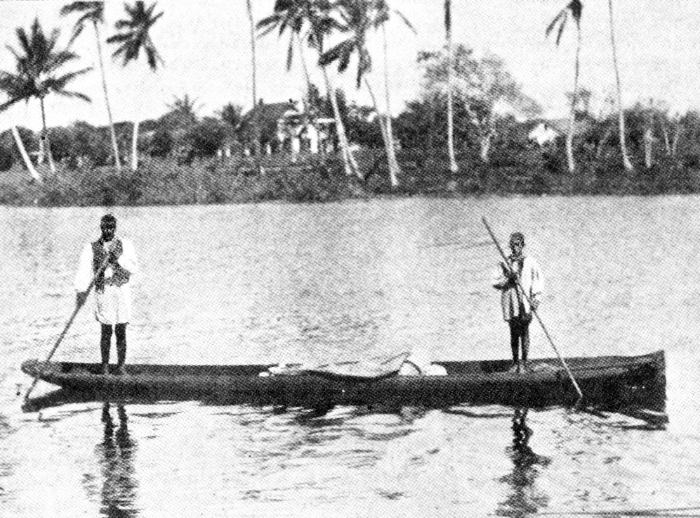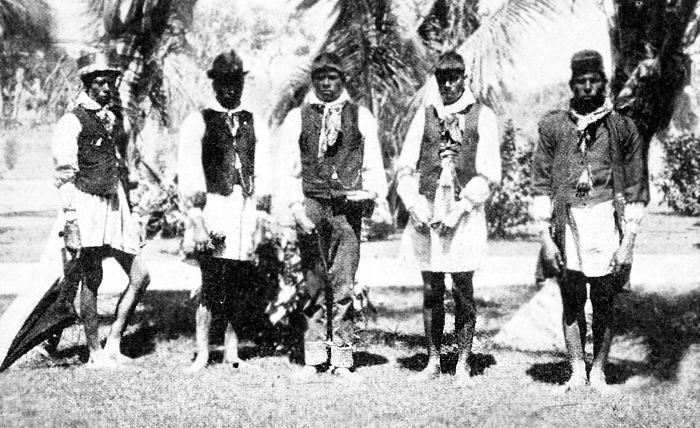| Home > Floripedia > Miami, Florida | |
Miami, Florida
The Official Directory of the City of Miami and Nearby Towns1904

Biscayne BayOnly ten years ago the present thriving town of Miami, Fla., whose growth has been so phenomenal as to give it the title of "Boom City," contained only one house, and its inhabitants, composed of one white family and a few negroes in scattered huts on the edge of the Everglades, were content to dream the days away, looking out over and across the placid blue waters of hallow Biscyane Bay, access Virginia Key, to the bluer waters of the Florida channel beyond.

Miami RiverA few miles further down the land side of Biscayne Bay was the pleasant little settlement of Cocoanut Grove, whose most prominent residents were the author Kirk Munroe, his family, and his cousin, Ralph Munroe. Still farther on to the south was the little hamlet of Cutler, and beyond nothing but desolation and the winking lighthouse on Cape Sable, the very southermost point of Florida.
Framed in a picture of blue waters under bluer skies and nodding palms that fringed the low coast, Miami was remote from civilization although the steamers bound to and from the northern and Gulf ports, could be daily seen across the keys, steaming with or against the Gulf Stream. It could only be reached by schooner from Key West, nearly 200 miles southwest, or by an occasional sailing boat through Lake Worth and New River Sound to the northward, from Jupiter, the southern end of the Indian river, to which steamboats plied from Titusville. There was consequently little travel to or from Miami.
Behind the place, to the westward, lay the mysterious and virtually unexplored Everglades, peopled only by stray bands of Seminole Indians, and stretching hundreds of miles away to the West Coast. There was, as now, the softest and balmiest of airs both summer and winter, a rich soil on the little ten-mile strip of land between Biscayne Bay and the Everglades, capable of producing at all seasons, pineapples, oranges and fruits. Deer and bear and wild fowl are abundant in the Everglades, and the waters of Biscayne Bay and of Florida channel teemed, as they do with almost every variety of food and game fish. It was a paradise for the sportsman and the hunter and the fisherman, and a land for the dreamer.

Seminole IndiansTHE MILLIONAIRE'S WAND
This was Miami and its surrounding country and waters only a decade ago. But the wand of modern and progressive multi-millionaire, Henry M. Flagler touched these shores and seas, and they awakened to new life. Where the Munroes fished and hunted and sailed and dreamed and wrote charmingly and alluringly of the earthy paradise they had discovered, now the railroad engine snorts, steamboats to Key West and steamers to the Bahamas and Cuba churn the waters of the bay into a foam, a fleet of yachts and houseboats lie at anchor or sails or steams around; one of five finest of modern resort hotels, the Royal Palm, shelters thousands of visitors and tourist every winter season, who overflow into new or smaller hotels and boarding houses.
Miami itself is a prosperous, thriving and growing town, with factories, churches, and other evidences of civilization while to the southward thousand upon thousands of acres of rich soil have been brought into cultivation, producing such crops of vegetables and fruits that Mr. Flagler has been obliged to extend the rails of his East Coast road thirty miles beyond Miami, below Cutler, and is contemplating laying them sixty miles further to Cape Sable.
This sudden development of a sleepy remote little hamlet into bustling, modern town, still to develop. Its residents and projectors believe and hope, with good reason, into an important sea port, is one of the most interesting chapters in the history of Florida. It is the very contrast that the comparatively few years have brought about that makes Miami most interesting, not alone to the few people who knew it as it was, but even to the visitor who finds his or her way there for the first time.
There is a sense of transformation in the air. Tall factory chimneys and the whistling of engines and steamers strike one as incongruous in these balmy airs and soft tropic surroundings. Solitude and the saw mill seem incongruous but they are found together at Miami. A short walk or drive from the center of the town, a short row from the hotel up the picturesque Miami river, brings the visitor into vast space and silence of the great Everglades, while almost an equally short sail or row across Biscayne Bay also brings the visitor to the low-lying keys, with their mangrove trees and tropic beaches, which fringe the western side of the Gulf Stream, and on whose eastern shores, looking out across the blue waters to the imagined Bahamas, only forty-five miles distant, out of sight and hearing of the town, one may dream strange dreams of the buccaneers in pirates of the Spanish main of Old and of the swift blockade runners of the later day.
LAND OF ENCHANTMENT
So Miami is a land of enchantment and of reality. It is old, yet modern; antique and yet new. But it is of the modern Miami that the world now most reads. Soon after Mr. Flagler had decided to develop Miami's more fashionable neighbor, Palm Beach, sixty-six miles to the north, he projected the improvement and development of the town and built the Borst Palm Hotel, on the northern bank of the picturesque Miami river, near the point where it debouches into beautiful Biscayne Bay.
The hotel built, and the town started on the boom, which still continues, Mr. Flagler set sail for the Bahamas, and like a new Columbus rediscovered Nassau, the capital of the "Isles of June," only two hundred miles eastward, where another great hotel, the Colonial, sprang into being under his magic golden wand.
Impressed by the fact that Miami offered the only harbor, not only of refuge, but for purposes of commerce, between Fernandina, nearly four hundred miles to the north, and Key West, some two hundred miles southwest, Mr. Flagler determined to make a channel and harbor in shallow Bicayne Bay, so that not only yachts and vessels of light draught could enter but that steamers could ply between Miami, Nassau, Havana, only two line dred and fifty miles away, and in time other Gulf ports. It was found that a channel could be made between Miami and Cape Florida, past the Fowey Rock lighthouse, on the outer reef, three miles to the deep waters, beyond.
MR. FLAGLER'S ENERGY
This undertaking, which would have discouraged almost any one except a man of Mr. Flagler's energy and determination and willingness to spend money on any project dear to his heart, was at once begun and after some two or three years was completed. The importance of the work to the commerce of the coast, not to speak of yachtmen, was hardly understood and appreciated.
Nearly half a million was expended by Mr. Flagler on the work which, while it has brought prosperity to Miami, has never been entirely satisfactory, owing to the currents and tides, which are continually shoaling the channel still especially the bar.
Now the government has at last awakened to the importance of Miami as a port, has appropriated some two or three hundred thousand dollars for the blasting out of a new channel directly across Biscayne Bay, some four or five miles only; the cutting of a canal across the Key to the north of Norris Cut, and the building of jetties to the deep water near the shore that point, which it is thought will in two years' time give entrance to the port to vessels of deep drought. Mr. Flagler and the East Coast Company have also appropriated a sum to dredge a basin inside the Key, in which vessels, particularly yachts, may lie secure from storms.
Miami, like Palm Beach and Nassau, has as a winter resort, a character and atmosphere distinctly individual and unique. It is preferred by many people to the more fashionable and artificially beautiful Palm Beach, and it has a clientele every winter of well-known men and women who resort there in December and remain until April. They find at Miami opportunities for the enjoyment of fishing, driving, riding, cycling, golfing, bathing and yachting, free from the restraints and formalities of conventional society life, and where no necessity exists for expensive costumes and entertaining.
Daily parties cross Biscayne Bay to bathe in the winter resort to bathe in the warm surf of the Gulf Stream as it dashes on the outside beaches of the keys, or dive and swim in the pool of clear water adjoining the hotel.
Daily, the fishermen go out to return at evening with silvery freight of the gamey Spanish mackerel, king-fish and crevalle, and occasionally other parties in larger yachts repair for periods of two or three days to Alligator and Caryfort reefs to bring back the fierce barracuda, the amber-jack and the shark, and occasionally the tarpon, as their prey. There are walks and drives to be taken, excursions to the Everglades and Cocoanut Grove, and golf in the hotel grounds, while almost every day the steamers from Havana and Nassau and the steamboats from Key West come in and out with their loads of tourists and their friends.
Houseboating at Miami is also a feature. The handsomest houseboat there this winter is the Bonita owned by General Louis Fitzgerald, of New York, who is occupying it with his family. The Bonita is moored in the Miami river near the hotel, and is always an object of interest.
But the chief attraction of Miami is its wondrous climate. So balmy, so soft and so sweet is it that it seems as if storms never swept there. - N. Y. Herald, March 13,1904.
Source:
Excerpt from "Beautiful Miami on Biscayne Bay" The Official Directory of the City of Miami and Nearby Towns, 1904.
| Home > Floripedia > Miami, Florida |
Exploring
Florida: A Social Studies Resource for Students and Teachers
Produced by the Florida Center for Instructional
Technology,
College of Education, University of South Florida © 2005.